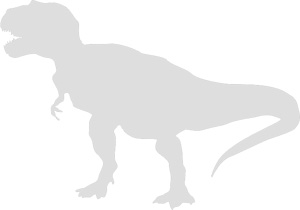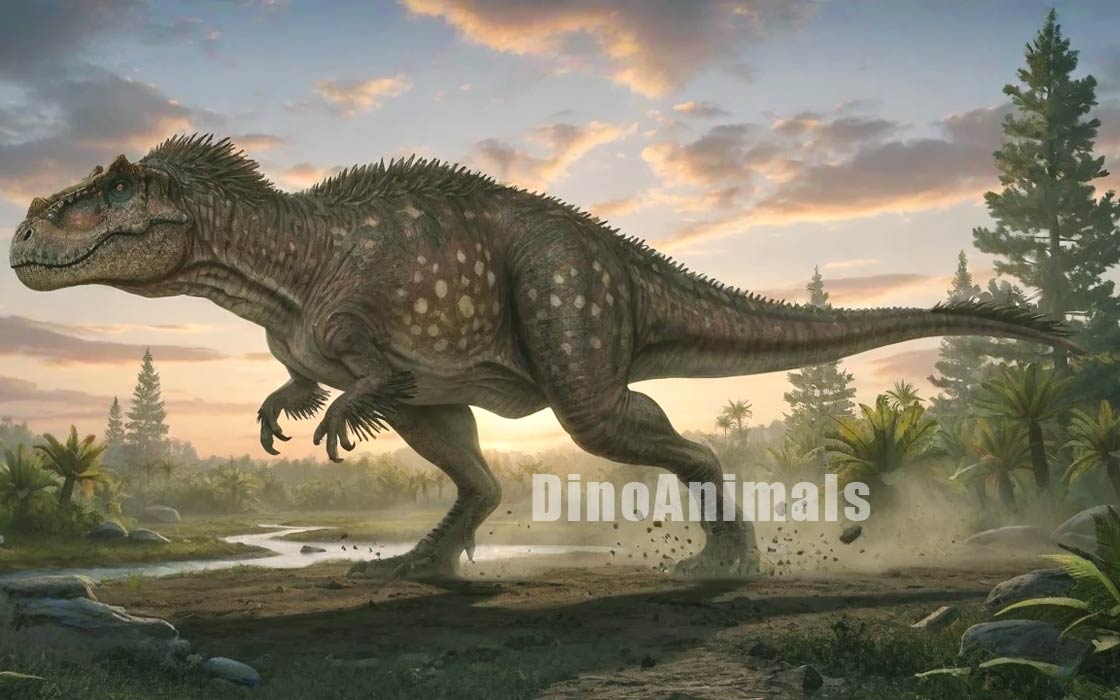Every month, 100,000 readers use the Dinosaur Database, but we receive no support from you. Developing and updating the database requires a lot of work. If you want it to remain open and be updated, please support us via the "Buy us a coffee" button available on every page or via the Support page.
Dinosaur: Tameryraptor markgrafi

| Length*: | 10.7 m | 35.1 ft |
| Weight*: | 4.8 t | 10,582 lb |
*The largest known specimen
Period
Epoch: Late Cretaceous
Stage: Cenomanian
Years: 100.5–93.9 Ma
Details
Status: valid
Author: Kellermann, Cuesta & Rauhut
Year: 2025
Distribution
Area: Africa
Country: Egypt
Region: New Valley Governorate
Formation: Bahariya
Description
Tameryraptor markgrafi
Tameryraptor markgrafi was a large theropod dinosaur belonging to the Carcharodontosauridae family, which lived in North Africa during the Late Cretaceous period. It was discovered in the Bahariya Formation in Egypt and was initially thought to be Carcharodontosaurus saharicus. However, recent re-evaluation of the available fossil material has led paleontologists to assign it to a new genus. The species name honors Eberhard Fraas and Richard Markgraf, early paleontologists who contributed significantly to North African dinosaur discoveries.
Physical Characteristics
Although Tameryraptor markgrafi is known from incomplete remains, its estimated length was likely between 10-11 m (33-36 ft), making it a large carcharodontosaurid. The preserved skull fragments, including the nasal bones and parts of the maxilla, suggest a long and robust skull with sharp, serrated teeth adapted for slicing through flesh. Notably, Tameryraptor had a distinct nasal crest or horn, a feature uncommon in other carcharodontosaurids.
Its axial skeleton shows adaptations for a powerful, fast-moving predator. The cervical vertebrae were strongly opisthocoelous (convex in the front, concave in the back), suggesting a flexible and muscular neck. The anterior caudal vertebrae exhibited pneumatic features, which might have helped in weight reduction. Its forelimbs remain unknown, but based on close relatives, they were likely relatively small compared to its body size. The hind limbs were strong, with robust femora indicating a powerful stride.
Distinguishing features of Tameryraptor markgrafi include:
- Size and Stature: A large theropod, approximately 10 meters in length.
- Teeth: Symmetrical teeth, well-adapted for slicing. The maxilla likely had 12 or 13 alveoli.
- Nasal Horn: A small, distinctive nasal horn located on the medial rim of the nasals.
- Maxilla: The maxilla exhibits a well-developed antorbital ridge. The alveolar margin is gently convex.
- Vertebrae: The neural arch was low. Deep spinopost- and spinoprezygapopyseal fossae were present, delimited by well-developed spinopre- and spinopostzygapophyseal laminae.
- Ribs: The proximal part of a dorsal rib was plate-like and double-headed.
- Chevrons: The chevrons were transversely compressed and slightly anteroposteriorly expanded distally.
- Femur: The femur had a spike-like accessory trochanter.
- Fibula: The proximal fibula was more anteriorly than posteriorly expanded.
Diet and Feeding Habits
As a member of Carcharodontosauridae, Tameryraptor was an apex predator, preying on large herbivorous dinosaurs in its ecosystem. Its teeth were blade-like, with finely serrated edges ideal for cutting through flesh. Interestingly, the preserved teeth show a symmetrical, almost “shark-like” shape, a feature that distinguishes Tameryraptor from Carcharodontosaurus saharicus, which had more recurved teeth. This could suggest differences in prey selection or feeding mechanics.
Habitat and Distribution
Tameryraptor markgrafi lived in what is now Egypt, specifically in the Bahariya Oasis region, which during the Late Cretaceous was a lush, river-dominated environment with seasonal flooding. This ecosystem supported a diverse range of dinosaurs, including large herbivores and other predators such as Spinosaurus aegyptiacus. The presence of Tameryraptor in this region suggests that large allosauroids were still significant predators in North Africa during the mid-Cretaceous.
Behavior and Social Structure
While direct evidence of social behavior in Tameryraptor is lacking, comparisons with related carcharodontosaurids suggest it may have been a solitary or opportunistic hunter. Some carcharodontosaurids, like Mapusaurus roseae, have been found in bonebeds, suggesting possible group behavior, but such evidence is absent for Tameryraptor. Its large size and powerful build would have made it a dominant predator in its environment.
Discovery and Research
The fossils of Tameryraptor markgrafi were originally discovered in the Bahariya Formation and described by Ernst Stromer in the early 20th century. However, the original material was destroyed during World War II, leaving only Stromer’s descriptions and photographs. Recent studies have re-examined the available evidence, including a newly discovered photograph of the original specimen, leading to the conclusion that this theropod was distinct from Carcharodontosaurus saharicus and warranted its own genus. The research, published in 2025, has provided new insights into North African carcharodontosaurids and their diversity.
Initial Discovery and Loss of Fossils
- Discovery in 1914: The fossils of Tameryraptor markgrafi were first discovered in 1914 during a German paleontological expedition led by Ernst Stromer in the Bahariya Formation of Egypt. The holotype specimen, SNSB-BSPG 1922 X 46, included partial skull bones, vertebrae, and leg bones.
- Classification and Subsequent Loss: Initially, Stromer classified the specimen as part of the related genus Carcharodontosaurus. However, the fossils were destroyed during World War II, leaving only archival photographs and written records.
Rediscovery Through Archival Research
- Re-examination of Historical Records: In 2025, a team of paleontologists re-examined Stromer’s archival photographs and written descriptions. This led to the realization that the specimen represented a distinct, previously unknown species.
- Naming the Species: The new species was named Tameryraptor markgrafi, with “Tameryraptor” meaning “thief from the beloved land” and “markgrafi” honoring Richard Markgraf, the fossil collector who originally exhumed the remains
Significance and Interesting Facts
- Tameryraptor markgrafi was originally misidentified as Carcharodontosaurus saharicus for nearly a century before being recognized as a distinct genus in 2025.
- It possessed an unusual nasal “horn” or crest, a feature not commonly seen in other carcharodontosaurids.
- Its teeth were less curved than those of Carcharodontosaurus, possibly indicating a different feeding strategy.
- It lived alongside Spinosaurus, one of the largest theropods ever, which raises questions about how these two predators coexisted in the same ecosystem.
- The original fossils were lost during WWII, making Tameryraptor one of the many “lost dinosaurs” known only from historical records and photographs.
Locations
Sources
Material: Holotype: SNSB-BSPG 1922 X 46: Left and right nasals, left maxilla, right maxilla (fragmentary), braincase (including fused frontals, parietals, partial supraoccipital, and right otoccipital), endocast of the braincase, several isolated teeth, axis (second cervical vertebra), two additional cervical vertebrae, one anterior caudal vertebra, left and right pubis, partial left ischium, both femora, left fibula, proximal part of a dorsal rib, two anterior chevrons.
References: Kellermann, M., Cuesta, E., & Rauhut, O. W. M. (2025). "Re-evaluation of the Bahariya Formation carcharodontosaurid (Dinosauria: Theropoda) and its implications for allosauroid phylogeny". PLoS ONE 20(1):e0311096




